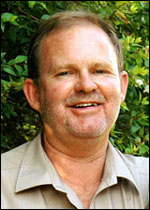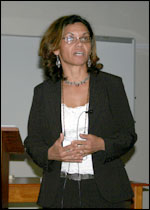Johan's monthly comment
|
Brief assessment of the first SAEON Summit
The SAEON Summit resulted in a shared vision for a comprehensive SAEON system that delivers reliable data, adopted by the 131 delegates as a result of the convincing content of the 20 papers presented by a succession of powerful speakers on the first day.
The SAEON Summit, as a biennial scientific conference to be organised by the SAEON National Office, is prescribed in the Standing Rules of SAEON, and was consequently listed as a goal in the 2005-2006 Business Plan.
The First SAEON Summit was indeed planned and organised by the SAEON National Office in consultation with the SAEON Technical Steering Committee and a Summit Reference Group consisting of three associated scientists.
Integrative outcomes
The Deputy Minister of Science and Technology opened the Summit, highlighting the national need for an environmental observation system delivering reliable data, and the need to integrate those observations across fields and observation systems. These points were supported throughout the Summit and were finally captured as follows in a Declaration:
|
It would be fair to say that the Summit resulted in a number of "firsts". It was the first time that divergent disciplines across the full spectrum of environmental science were assembled to share the same platform and to participate in the same workshop. It was also the first time that researchers and practitioners of ICT and science education shared a platform with research scientists. Contrary to expectations, more delegates attended the ICT workshop at the Summit than the core science workshop. This demonstrates a significant growth in ICT awareness in the research community, and wide-ranging support for the national information management network being developed by SAEON.
Summit delegates, representing the broad spectrum of disciplines and fields involved, participated with persistent interest. This is demonstrated by the fact that attendance on the second day was down by 5% only. The traditional territories of marine, atmospheric, freshwater, terrestrial ecology and socio-economic research, were not defended and considerable progress was made towards an integrated approach. This was made possible through the shared vision for a comprehensive SAEON system that delivers reliable data, adopted by the delegates as a result of the convincing content of the 20 papers presented by a succession of powerful speakers on the first day, attended by 131 delegates.
The second day, attended by 124 delegates, was devoted to three 5-hour workshops to develop a core observation plan, sharing concepts and information within the field of information management, and the further development of the SAEON Education Outreach programmes respectively. The three workshops gave feedback to the plenary, and floor discussion followed. A leading South African scientist presented an overall summary and this led to the adoption of the Summit Declaration quoted above.
Capacity development outcomes
The SAEON Graduate Student Network was launched by the Deputy Minister of Science and Technology as part of the evening function on the 27th March 2006. At the same function three prizes were awarded to the winners of a Students' Poster Competition run as part of the Summit.
These capacity development events were followed by a successful training and discussion workshop organised by the Graduate Student Network where 37 students from just about all the South African universities interacted with environmental scientists, a professional science communicator, information management specialists, the SAEON Ndlovu Node manager and the SAEON Education Outreach coordinator.
This was the first activity organised by the Network and it did not only benefit the participants, but it was also gratifying to observe the personal growth in stature of the four committee members who were solely responsible for the organisation and running of the meeting. It was remarked more than once that the event provided the participants with learning opportunities that they never receive as part of their formal training.
Branding outcomes
The first SAEON Summit benefited from participation by various Government structures, and the NRF and Department of Science and Technology, as the governmental custodians of SAEON, were given the most prominent exposure through the Deputy Minister's involvement, provision of NRF stationery, the display of DST banners, co-branding on SAEON webpages, banners and posters, and several references to the NRF's and DST's roles throughout the Summit. South African National Parks and the South African Institute for Aquatic Biodiversity, the hosts of the two existing nodes, were also co-branded on the Summit website and programme documentation.
So far the Summit has received media coverage in Sunday Times, Rapport, Beeld, Die Burger, Engineering News, East Rand Radio, the Phychological Society of Southern Africa Newsletter, the Institute of Environmental and Recreation Management website, the BIOTA Africa website, Environmental Information Systems Africa News and news@NRF. Detailed coverage of the Summit will be communicated via the SAEON electronic newsletter and SAEON website. Most of the scientific papers presented, as well as a summary of the Summit, will be published in the South African Journal of Science. First authors and session chairs were given ample profiling in the programme documentation.
Overall, SAEON's own brand as an institutionalised network organisation with multiple organisational stakeholding was promoted actively and visibly. It was clear from comments received and statements made during the course of the Summit that it succeeded very well as a marketing and communication initiative to create greater awareness and buy-in.
A rapidly expanding SAEON
The Summit obtained resounding support for the SAEON concept. It is also pertinent to note that the establishment of Nodes which was initially planned to be a linear process, was fast-tracked during the 2005-2006 financial year on the advice of the DST through the SAEON Advisory Board. This resulted in the recent establishment of the SAEON Elwandle Node for the coastal-inshore zone, with two more nodes close to finalisation. This will be followed by the initiation of processes to establish the final two nodes. In addition, DST staff members who are responsible for the South African National Antarctic Programme have approached SAEON to assist in establishing a SANAP data management node with earmarked funding.
"It would be fair to say that the Summit resulted in a number of "firsts".
Statement of appreciation
Finally, I must convey SAEON's network-wide appreciation to those who contributed to the SUMMIT and its success, resulting in sound guidance and continued valuable support for the programme.
I trust that the Summit has reinforced your vision for SAEON.












